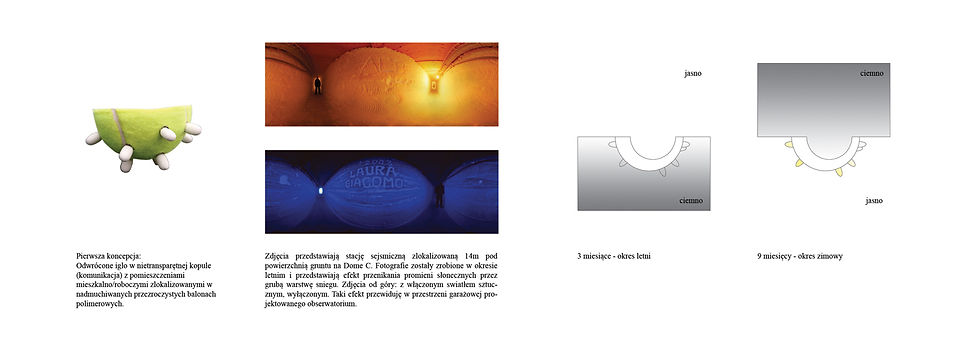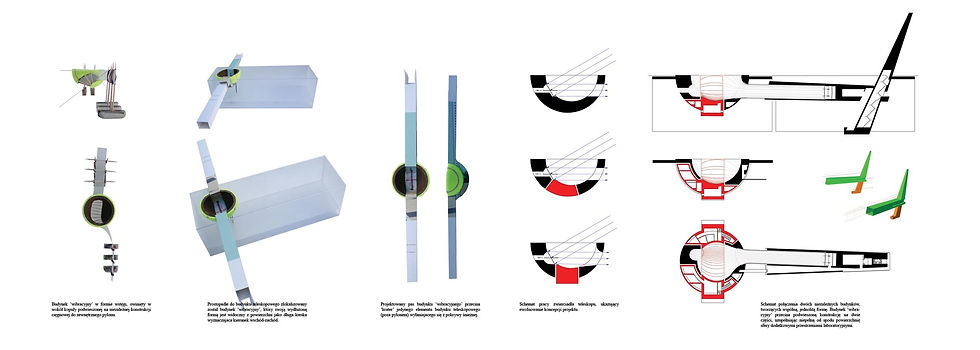
ADAMANKIEWICZ ARCHITECT

Fig.1. Observations
IDEA
Humanity, surrounded by a never ending sea of stars, has speculated about the existence of other planetary systems and life beyond Earth for a long time. Four centuries after the visionary reflections of Giordano Bruno we have reached a time in which we have a chance to find answers to some of the questions to do with life beyond Earth. In the last few ceturies a huge development in learning has coincided with speedy technological developments. Instruments allowing us to register invisible radiation have now joined already existing telescopes. New theories have started accompany space missions as well as the scending of satellites into particularly every corner of the planetary system.

Fig.2.
First concept:
An inverted igloo in a non-transparent dome (communication) with living/working quarters located in inflated transparent balloons.
The photographs show the seismic station, located 14 meters under the ice surface at Dome C. The photographs were taken in Summer and present the effect of permeating sun rays through the thick ice pack. Photograph from the top: with artificial light, turned on. This is the effect that I expect in the garage area of the observatory.
3 months of Summer time.
9 months of Winter time.
The largest, 10 meter telescopes are now collecting, unbelivable until recently, information and causing scientists to pose new questions. The answers needed for these questions are accompanied by quickly developing technology which, through the development of new instruments with ever larger possibilities, is bringing us nearer to certain solutions. Telescopes with a radius of 25, 30 or even 100 meters are already in the design phase (so called Enormous Telescopes). Scientists are placing huge expectations on the exploration of new planetary systems with these telescopes. If one looks into the history of astronomy than one notices a certain pattern in its development. The 20th century especially, shows us that trends exist in doubling the radius of telescopes every few dozen years. This is important as far as, if we increase it twofold, then we are able to see objects whose light is fourfold weaker. For example, in 1917 the 2.5 meter Hooker Telescope was created on Mount Wilson, in 1948 the 5 meter Hale Telescope was constructed, in 1993, two 10 meter twin telescopes were built on Mount Kea in Hawaii. If we follow the developments of telescope radius enlargements then the next, 20 meter telescope should appear in the year 2025. Huge telescopes such as TMT - Thirty Meter Telescope, 24 meter GMT - Giant Magellan Telescope as well as 100 meter OWL. Overwhelmingly Large Telecope, are however expected to appear in the middle of the next decade. The OWL is 10 times larger than the largest optic instruments built so far and breaks out of the doubling enlargement tradition.

Looking for a solution to separate the building from the ice surface in order to stop the process whereby the building melts into the thickening ice mass, as well as going deeper into the ice (the ice pack is 3200m high at this point).
Fig.3. Looking for a solution to separate the building from the ice surface in order to stop the process whereby the building melts into the thickening ice mass, as well as going deeper into the ice (the ice pack is 3200m high at this point).

The concept of the Schmidt telescope as a part of the building, suspended on the steel rods structure.
In the last half century it was not only the changeable sizes of the mirror which were the reason for a significant improvement in quality and picture clarity. The first telescopes were fixed with special detectors, which were formed from photographic plates, which picked up only a few percent of the light which fell on them. Currently the photographic instruments have been replaced with electronic detectors which pick up 100% of the light increasing the power of the telescopes fivefold. This is however as far as electronic detectors go. Their possibilities cannot be significantly increased. For this reason the only hope of scientisis, for bettering the picture from the telescope is to enlarge its radius.
Here in turn, problems appear which are not only financial but mostly linked with compiling the right materials. These are two variables which influence the size of the telescope most. These limitations are linked chiefly with the amount of the right quality of glass as well as problems with moulding it into an ideal shape. Modern technolgy is limited so that we are not able to mould even a 15 meter mirror. For example, the area of the 5 meter Hale telescope was polished with an exactness which did not diverge from the ideal by more than 50mm. Attaining such a quality took 11 years. Currently the creation of an 8.2 meter mirror takes approximately a year. All the difficulties were overcome however. Already in 1932 famous Italian astronomer Guido Horn D'Arturo proposed the creation of a huge mirror from individually designed, smaller segments. This solution was used in the twin Keck telescopes, in which the main mirrors were made up of 35 six angled segments with a radius of 1.8 meters. The OWL and TMT telescopes will be equipped with similar mirrors. The next problem of huge telescopes is the super-construction, which will not only have to contain the mirror but also assure accurate mobility of the machine, allowing it to follow the objects being observed.
The weight of the OWL was preliminarily estimated at approximately 10,000 to 15,000 tonnes (the weight is comparable to the Eiffel Tower: when it was built, the Eiffel weighted exactly 10,000 tonnes).
Fig.4. The concept of the Schmidt telescope as a part of the building, suspended on the steel rods structure.
The constructors therefore stand before a huge challenge. Various methods of embedding the structure are under consideration such as thin layers of oil for example, after which the telscope could float. Magnetic levitation is also under consideration.
There is another problem with the construction of such large instruments which has to be mentioned. The picture that reaches instruments on Earth covers kilometres of our atmosphere in which it under goes deformation as a result of the present turbulence. This occurs mostly due to a mixing of air masses with various thicknesses, speed and temperature. The other reason for the deformities is the process of evaporation. The disturbance of all observations made from Earth can be compared to once which occur when objects are observed at the bottom of the swimming pool. A technique of adaptive optics, whose job is to eliminate these atmospheric disturbances, was developed. The method is based on the montage of a large number of small pitons (so called activators which are computer controlled), which put pressure on the back area of the mirror. This adaptive technique was used in the construction of many modern telescopes but it is not known whether it can be successfully used on the 100 meter OWL. The uncertainty is a result of the fact that such a large mirror area should be serviced by 100,000 activators whereas in modern instruments this number is much smaller and numbers under 1,000. The computer, which controls the small pistons, corrects the shape of the mirror a few hundred times per minute. With a 100 meter mirror and the current level of modern technology this is impossible.

40 KEOPS telescopes spread out on a 1km radius. The hope for finding life beyond Earth (the largest telescope is currently 11 meters wide).
Fig.5. 40 KEOPS telescopes spread out on a 1km radius. The hope for finding life beyond Earth (the largest telescope is currently 11 meters wide).
Yet, what is a 100 meter telescope compered to the vision of Professor Antoine Labeyrie from the French observatory in Haute-Provence, whose dream was to discover tropical forests, oceans and other worlds many lights years from our Earth. With this in mind he designed a huge hyper-telescope. Currently the list of discovered planets is only at 160 and all of them are much larger than Earth. The smallest is 5.5 times heavier that Earth.
Despite a lack of proof, most astronomers are convinced that Earth-like planets exist in outer space but that it is especially hard to discover them even using today's modern technology. All the modern methods of searching for such celestial objects are based on indirect methods. one of these is the analisis of the volume of light emitted by stars when they are shadowed by objects being searched for (transit method). Another more complicated method is microlensing or the spectroscopic method.
Today it is known that the discovery of the forests, which Labeyrie dreamt of, could be made using mirrors with a minimum diameter of approximately 100 km to carry out analysis. With the current plans for 30 meter telescopes the solution remains a mere abstraction. In accord with Professor Antine Labeyrie's assumptions a possibility exists of carrying out observations using a method called optical scattering (or interferometer method). He is working on a concept of a lot of small telescopes which work together and would in a sense create one huge telescope.
In the planned solution a skull with a radius of 100 km consisting of 150 small 3 meter telescopes would be placed in specific places in the cosmic sphere. The enormous creation will catch less light from its full counterpart, but it will compensate this with a longer observation time. It will definitely keep its resolution as it depends on the distance between the furthest elements of the skull.

The concepts of the building
Fig.6.
The concept of the building with a laboratory/living function on a steel structure.
The laboratory/living building on its own structure, placed directly under the dome, which is connected on an independent steel rod structure to the external pylon. The solution guarantees dilatation between buildings and stops vibrations made by users from reaching the dome, which houses sensitive measuring instruments. View from the bottom (from the snow ditch).
View from the top (external). The openings cut in the dome allow more light to get to the vibrating building.
Due to the small space available in the design shown in the pictures 1, 2, 3, the vibrating building is subject to further modifications. Its simple elongated form is marked in blue.
The vibrating building cuts the telescope building (dome) in 2 parts, filling the missing elements.
In order to gain a greater area, the drawing shows a two-story vibrating building.

The connection of two independent buildings, which create a joint, uniform form. The vibrating building cuts structure in two filling the incomplete area (from the bottom) with additional laboratory space.
An ideal example illustrating the work of such an instrment is the mirror of the largest current telescope, the Keck, found on Mauna Kea island in Hawaii. If 30 from 36 segments of the mirror were damaged its sensitivity would worsen and the ramaining 6 fragments would gain much less light. The telescope would continue to function however, if the elements on the opposite ends of the mirror remained untouched, as its resolution would remain the same. The next ideas after Labeyrie see the realization of projects located on Earth which are using interferometer methods with success. These are for example:
- GI2T (Grand Interferometer a 2 Telescopes) - one of the oldest such machines, working since 1985, it contains two 1.5 meter telescopes at a distance of 65 meters from one another,
- SUSI (Sydney University Stellar Interferometer) - built in 1992, it is made up of eleven 20 cm instruments with the possibility of locating them at a distance of 640 meters from each other,
- COAST (Cambridge Optical Aperture Synthesis Telescope) - built in 1992, it is made up of five 40 cm instruments with the possibility of distancing up to 67 meters,
- VLA (Very Large Array) - has 27 radio antennae with a diameter of 25 meters on the San Augustine plateau in New Mexico,
- VLTI (Very Large Telescope Interferometer) - constructed in 2001, it consists of 8 meter telescopes plus three smaller 1.8 meter,
- ALMA (Atacama Large Millimeter Array) - the project has 80 antennae spread on the Chile desert.
Fig.7.
The vibrating building in the form of a coil, wrapped round the dome, which is connected on an independent steel rod structure to the external pylon.
The vibrating building is perpendicular to the telescope building. Its elongated form is visible from the surface as a long line that shows the east and west directions.
The line of the vibrating building cuts the crater of the only element of the telescope building (apart from the pylon), which comes out of the snow surface.
The diagram to show the mirror of the telescope, showing the evolving project concept.
The diagram showing the connection of two independent buildings, which create a joint, uniform form. The vibrating building cuts structure in two filling the incomplete area (from the bottom) with additional laboratory space.
All the above land telescope projects confirm the effectiveness of the interferometer method of observation and give scientists much cause for optimism in the future. Creating instruments specially designed for this type of observation is definitely a cheaper process to the construction of 100 meters skulls. The structure itself becomes definitevly lighter and less complicated and the range of observation significantly increases.
One could be let to the assumption that the golden age of astronomy is beginning. Here Labeyrie's vision is not at all unrealistic and does not have to be as distant as one might think. The only problem is financing of course as building whole fleets of cosmic mirrors would cost billions of dollars. The current situation in space agencies forces them to withold various projects due to budget cuts so unfortunately the realization of the telescopes is delayed. ed.

Hydraulic lifting of the building resulting from 10cm of annual snow accumulation; using such a solution allows the building to be kept on the surface.
Fig.8.
In case there is an unforeseen storm, I will plan for the hole to be covered, to protect it from being submerged in snow. The structure has to be light, that is why it is better to use a pneumatic solution, e.g. in the form of an inflated ball.
Problem: snow massing under the ball.
The narrowing openings in the ball allow the free passage of wind and snow to be blown out from under the dome.
Pneumatically opened/closed dome.
Hydraulic lifting of the building resulting from 10cm of annual snow accumulation; using such a solution allows the building to be kept on the surface.